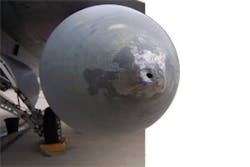Forensics. The mention of the word brings to mind television shows about crimes and autopsies. The dictionary says it’s the scientific analysis of physical evidence. But what does the science of forensics have anything to do with aviation? When it comes to foreign object debris (FOD) the answer is, quite a bit, at least if you choose to take advantage of a really great scientific tool. But more on that later.
To hear the old-timers talk (I’m an old-timer but not that old), FOD wasn’t such a big deal in the heyday of the big radial engines. You didn’t want to drop a washer down a carburetor or leave loose hardware inside an engine during assembly, but generally speaking an old removed cotter pin was not going to cause the complete destruction of the engine or millions of dollars of damage. Yes, there were exceptions for you hangar lawyers out there, but they were exceptions rather than the rule.
That changed with the advent of the jet engine with lots of tiny little blades spinning at high speed and vacuuming up every loose object within reach of an invisible vortex. Even the seemingly most innocent and smallest piece of debris could now cause the loss of an aircraft, extreme damage to an engine, or at the least, disruption in aircraft availability.
In the case of the recent Canada Geese vs. aircraft incident, the cause is easy to determine. Once you’ve seen and/or smelled the results of bird ingestion, you never forget the sensory impact and you always remember the smell of whole cooked bird, feathers and all. But what about when you find FOD damage to the engine and the cause isn’t immediately obvious? Do you just blow it off and say, “Oh well, that sort of stuff just happens?” Hopefully we’ll do our best to look deeper because it can be very expensive to do otherwise.
Military applications
Contrary to popular opinion, the U.S. military is interested in being cost effective, but even more so they are concerned about preserving combat assets and their availability. In civilian terms, that means we work hard to have aircraft available and capable of performing the missions our government assigns. It’s just a simple fact that crashed and broken aircraft don’t do anybody any good, except maybe the bad guys out there. FOD is a hazard that’s particularly impactful to single engine fighters like the F-16 and the upcoming F-35. The military has had FOD awareness and prevention programs in place almost since the inception of jets, and most FOD damage is preventable by one means or another. But before you can put a fix in place, you have to know the root cause.
Take for example a recent incident at the 122nd Fighter Wing in Ft. Wayne, IN. The 122nd is a combat veteran Air National Guard unit flying F-16C Fighting Falcon aircraft. The Viper (the real nickname of the F-16) is well known for being a FOD sucker and the low slung intake and the high volume of airflow of the engine create the ideal ramp vac. With the engine running on a humid day you can usually see a vortex that comes out of the intake and curves gracefully down to the ramp and madly spins around like a mini Texas-Twister, sucking up everything in its path. Needless to say, F-16 bases have ramps you could eat off of because they are FOD walked daily and vacuum sweeper trucks are constantly in operation. However, even with the best efforts, sometimes FOD damage happens, and when there are rashes of similar events people start getting really worried.
Analyzing engine damage
Over a period of a few weeks in the summer of 2008, 122nd FW maintenance personnel noted a rising trend in FOD events. Two aircraft had sustained airframe damage to a ventral fin and a strake, both caused by an impact of an unknown source, and in the same time frame two engines also received blendable FOD damage. We are not talking just a little ding here and there. Both engines had fan and IGV blades damaged which required further inspection and blending. These events were found during postflight inspections by the aircraft crew chiefs, which means that the aircraft received the damage after launch and probably flew that way.
The base FOD Monitor, SSgt. George McMillen, took samples of the damage using the newly acquired FAST (Failure Analysis Service Technology Inc.) FOD kit and sent them out for analysis. The kit takes a nondestructive sample using sticky tape and acetone which is then analyzed using a scanning electron microscope. The makers of the FAST FOD kit then read the atomic makeup of the residual debris on the sample and determine the composition of the culprit. Safety wire has a different chemical signature from an aircraft grade bolt, and when items impact the engine they leave behind their unique chemical fingerprints.
As was noted earlier, forensics is the scientific analysis of physical evidence and this process is really comparable to lifting a fingerprint. In this case, the results came back stating that concrete had caused the damage. The signature not only included concrete, but it also showed paint with a slightly metallic characteristic.
Shortly thereafter the crew chiefs started noticing paint chips lodged in the aircraft tires and subsequent examination of the runway revealed heavy flaking of the paint used for the runway numbers and stripes. The paint had multiple coats over years of repaints and the concrete was breaking loose underneath. Recent repairs to the primary had dictated the use of this alternate runway which was not commonly used for fighter operations. The dents on the strake and ventral fin had also been caused by the paint/concrete being thrown against the airframe from the aircraft tires on landing. The problem was quickly solved by the 122nd and the local airport authority by having all the old paint removed and new reapplied.
CMSgt. John Maxson, chief of quality assurance, says, “The main runway was out of service for several weeks which caused us even greater concern because we were afraid we were using a runway with multiple problems. Bottom line: the FAST FOD kit clued us into a problem that may not have been resolved without the results provided by the manufacturer.”
In another nonrelated incident, an aircraft returned from flight with damage to the wing fuel tanks, one of which had a large hole in the nose of the tank. The pilot reported flying into heavy precipitation and FAST FOD analysis results showed no foreign fingerprint and the consensus was that the damage had been caused by hail. Even in this case there was an advantage to using FAST FOD because it helped determine that no further action was required.
Many other uses of the kit can be envisioned, such as determining damage to airframes from ground equipment, and even nonaircraft related incidents. Undoubtedly the use of the kits will continue to grow as aircraft maintenance personnel become more aware of their usefulness. Other branches of the U.S. military are implementing the use of the FAST FOD kit to help them improve FOD programs and help with investigations. There are many other success stories and there will, in all probability, be more as the kits see wider implementation. In this case it helps the 122nd to continue to be ready to meet any threats posed to the United States and its allies and to safeguard the aircrew flying the jets.
And of particular interest to us all — it saves the taxpayers money.
David Chamberlin has an A&P and a degree in aviation management. He is currently a senior customer service rep at Rolls-Royce and a quality assurance inspector with the Indiana Air National Guard.





